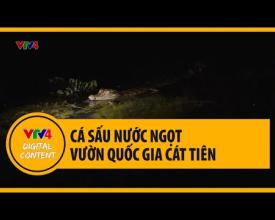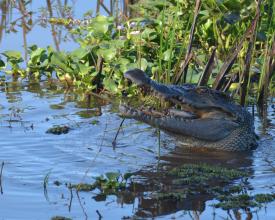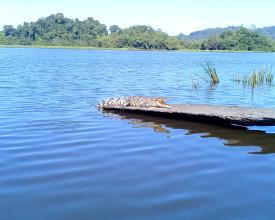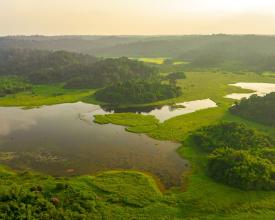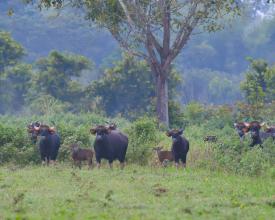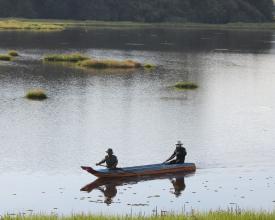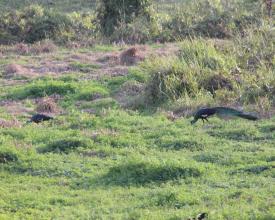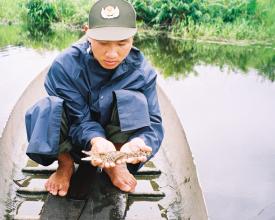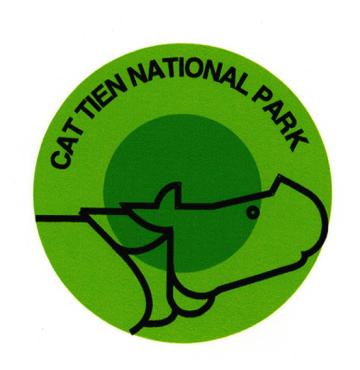
Successful rewilding Siamese Crocodiles in Bau Sau Ramsar Site, Cat Tien National Park
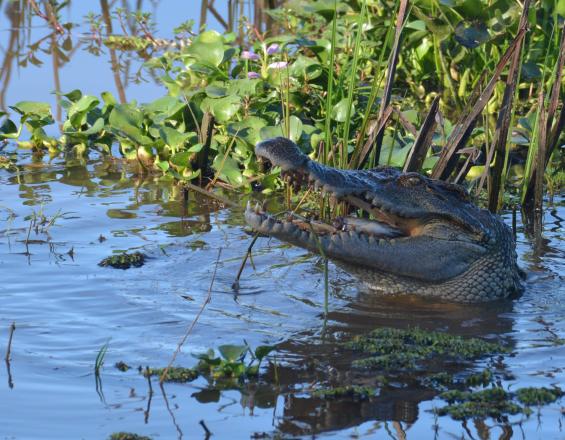
Located in the northwest of Cat Tien National Park, Bau Sau and surrounding wetlands, supported a large population of Siamese Crocodiles before 1980. However, since park was established in 1992, no crocodiles were recorded here. In addition, the natural habitats were heavily disturbed by encroachment for arable lands, exploitation of forest products, hunting and trapping animals, illegal fishing, etc.
The efforts for re-establishing a crocodile population in this area started in late 1990s. From 2001 to 2005, first 60 crocodiles were released into Bau Sau. In September 2005, the first baby crocodiles were recorded. To date, the Siamese Crocodile population in Bau Sau has developed stably with new juveniles recorded regularly over the years.
Together with Siamese Crocodiles, populations of other species using the Bau Sau area such as Gaur, Sambar, Green Peafowl and large water birds are also increasing steadily within the park.
Context
Challenges addressed
Siamese Crocodile was locally extinct in all Southern Vietnam.
Severe human pressures on the protected areas causing the degradation of habitat quality.
No example of success species reintroduction in Vietnam before this effort was initiated due to the lack of safe and suitable habitats.
Species reintroduction often requires huge financial resources and time-consuming.
Location
Process
Summary of the process
Since the late 1990s, the idea and efforts to set up a programme for re-establishing Siamese Crocodile populations in Cat Tien National Park were initiated. To implement this programme, many necessary factors had to be prepared, especially the readiness of habitat and prey for the reintroduced populations to become established. Before the establishment of the National Park, the wetlands in the park were an important source of livelihood for the local people living in the area. Therefore, two streams of work need to be done at the same time to i) ensure that the reintroduction of the species population is carried out according to scientific and conservation standards and procedures in accordance with international guidelines and ii) ensure that the released populations have a suitable and safe environment to thrive in, avoiding the risk of potential human-wildlife conflict.
Building Blocks
Reintroduction of a Siamese Crocodile population in Bau Sau lake, Cat Tien National Park
In 1998, site managers and scientists discussed the possibility of reintroducing a crocodile population at Bau Sau. This was because the lake was situated in the historical occupation range of the species, and at that time, the habitat quality had been improved and ready for a reintroduction program. Feasibility studies were carried out. The park also held discussions among experts, managers, and authorities at all levels to gain consensus on the program.
In 2000, with the support from international experts, purebred Siamese Crocodiles, which are believed to have provenance from Cat Tien area, were selected from a farm in Ho Chi Minh City, to training for restoring their natural behaviours. From 2001 to 2005, a total of 60 adults were released into Bau Sau. In September 2005, the first baby crocodiles were recorded.
Recent monitoring shows that the number of individuals is increasing, the distribution area is also expanding with records in some neighbouring lakes. As of 2019, monitoring data has recorded at least 286 individuals (including 228 juveniles). Up to now, it can be confirmed that freshwater crocodile populations have been successfully re-established in Cat Tien National Park. The number and structure of the recorded population ensures that this is a healthy and viable population.
Enabling factors
- Natural habitats of Crocodiles in Cat Tien National Park (Bau Sau and surrounding wetlands) are well protected and restored, prey populations are well maintained to facilitate the reintroduction.
- Source of breeds in the crocodile farms meet requirements in terms of genetics and epidemiology.
- There is enough scientific basis for a population reintroduction program.
- Supports from governments and international community helped the National Park managers have enough determination in re-establishing a Siamese Crocodile population.
Lesson learned
The success of re-establishment of a Siamese Crocodile population in Cat Tien National Park is the result of a joint effort of Vietnam and the international conservation community. This is a good lesson for future re-wilding efforts. Local political determination (local governments and site leaders) plays an important role in creating the necessary conditions for population re-establishment.
Important elements for this success include: i) available breeding stock for re-wilding, ii) safe habitats with sufficient prey sources, and iii) proper awareness on animal-human conflict for to ensure the compatible behaviours for long-term survival of the re-established population.
To date, the freshwater crocodile re-establishment programme at Bau Sau was recognized as the first successful crocodile reintroduction effort in the world, and it therefore can provide experience for other population re-establishment projects in future.
Resources
Mitigation of human pressures on the park’s natural resources
Before 1990, the area around Bau Sau was under severe pressures from local communities in Dak Lua Commune. Local people often entered the park for harvesting timber, fishing, and hunting animals. Conflicts between locals and forest rangers occurred frequently and seriously (with death, and a ranger station was burnt in 1990).
After establishment, the park managers focused on law enforcement. Number of donor projects in this period helped improving local livelihoods through productive and effective farming, e.g. irrigation, increasing rice crops cultivation from twice to three times/year, high yielding maize. With consensus from local people, households living in the core zone were supported to relocate to the buffer zones. Forest protection contracts were signed with local households, forest protection teams were established in villages around the park. Illegal activities were sharply reduced. Relationship with local communities has been improved, pressures on natural resources has reduced, and the habitat quality has been enhanced.
Along with proactive habitat restoration measures, wild fauna populations recovered rapidly. In addition to the Siamese Crocodile population that was re-established in Bau Sau area, other populations of animals of conservation concerns such as Gaur, and Green Peafowl etc. are well maintained.
Enabling factors
- New protected area policies have helped solving many limitations in the previous period.
- Appropriate conservation plans and strategies are in place.
- There are sufficient resources (human, financial) provided through nationally and internationally funded projects.
- Active participation of local communities in conservation work.
- New awareness on biodiversity conservation regarding restoration of wild native and threatened species.
Lesson learned
The conservation achievements of Cat Tien National Park could have only be achieved when the participation of the community was mobilised. Good strategic plans and sufficient financial investment have helped local communities redirect livelihood activities to reduce pressures on natural resources, thereby creating conditions for the restoration and improvement of the park’s biodiversity values.
Impacts
- Successfully re-establishing populations of Siamese Crocodile, which have been locally extinct in the Southern Vietnam since the late 1980s.
- Populations of other species of conservation concerns such as Gaur, Deer, Green Peafolw, etc. are also better preserved and have more development opportunities.
- Local awareness is improved, the lives of local people are stabilized, reducing dependence on the park's natural resources.
- The park’s conservation management work has been improved, with long-term and short-term plans, with supporting tools and equipment, reducing the workload of staff and enhancing management effectiveness.
- Bau Sau was restored to ensure that the functions of the wetland ecosystem are well maintained, including water storage and regulation, provision of good habitats for aquatic species whose life cycles depend on the water and wetland ecosystem of Dong Nai River basin.
Beneficiaries
Species using the Bau Sau area
Cat Tien National Park
Park visitors
Vietnam Conservation Agencies
Researchers
Local communities
Story
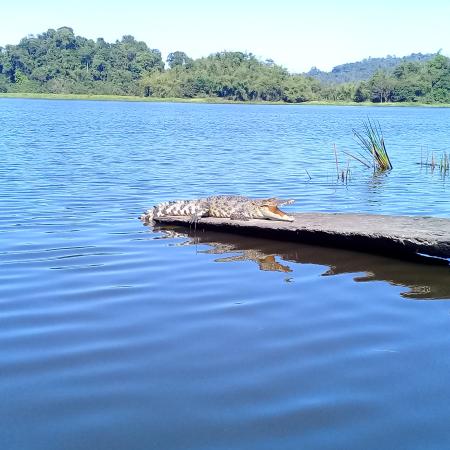
Dr. Pham Huu Khanh, Head of Science and International Cooperation has worked at Nam Cat Tien Forbidden Forest since 1987. At the time, the fledgling protected area was under severe pressures from encroachment on forest lands for farming; illegal logging; hunting and trapping of wild animals; and fishing with destructive methods etc. Wetlands in the northwest of the park were the most destroyed, where once large mammals and birds in the dry season were congregated, an abundance of freshwater fishes, and the home of Siamese Crocodiles. In addition, the invasion of Mimosa pigra, also contribute to the degradation of the quality of wetland habitats, leading to a decline in numbers of most species.
Before 1980, soldiers of the 600th Division described: "eyes of the crocodiles in Bau Sau at night is as dense as the stars in the sky". However, due to habitat loss and disturbance, and especially uncontrolled hunting of adult individuals for skin, meat and juveniles for farming, Siamese Crocodile populations of Cat Tien and of the whole Southeast region were severely reduced and locally extinct in the early years of the 1990s.
From 1998, with the support of central ministries, provinces and international organizations Cat Tien National Park has made many efforts to improve biodiversity conservation in the park. Especially, Cat Tien Conservation project in the core zones funded by the Dutch Government, and the buffer zone development project co-financed by the Dutch Government, the Government of Vietnam and the World Bank, that helped enhancing forest protection, biodiversity conservation, improving livelihoods of local people leaving in and around the park.
The reintroduction of Siamese Crocodile was started in the late 1990s. From 2001 to 2005, the park released a total of 60 adult crocodiles into Bau Sau. In September 2005, the first baby crocodiles were recorded. As of 2019, monitoring data has recorded at least 286 individuals (including 228 juveniles). Over the past 20 years, the crocodile population here has steadily grown, with new juveniles recorded regularly.
Now, every time visiting Bau Sau, Dr. Khanh always feel very happy and proud of the efforts of many generations of National Park staff, including myself, the support of the government and donors, so far has yielded clear results. In the future, generations of descendants will continue to admire the lord of the swamp basking in the sun and catching prey every time they visit Cat Tien National Park.
